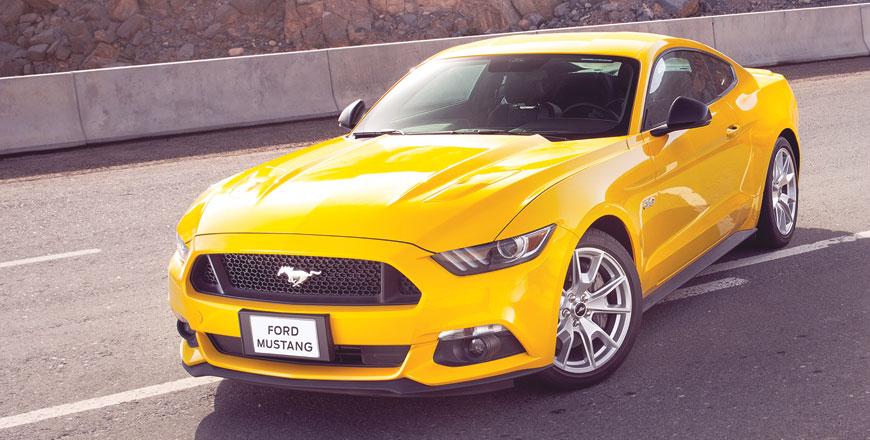You are here
Ford Mustang GT (auto): Lean, mean muscle machine
By Ghaith Madadha - Feb 18,2019 - Last updated at Feb 18,2019

Photo courtesy of Ford
The original muscle when appearing in 1964 and first to resurrect such cars in 2005, the iconic trend-setting Ford Mustang made stylish two-doors and performance cars more affordable and accessible.
The best selling ‘sports car’ nameplate ever, the Mustang retains a quintessentially American flavour, but since its sixth generation incarnation circa 2014 has become a more modern and global car.
Revised and face-lifted for 2018, with a leaner, meaner look and more power, the latest Mustang is also more efficient, advanced and refined, with new gearbox, digital instrumentation, driver assistance safety systems, improved cabin and subtle yet highly effective suspension recalibrations.
Dramatic and athletic
A classic front engine and rear drive sports coupe with a moody shark-like fascia, lasciviously long bonnet, rakish fastback roofline and curt boot, the Mustang also has near perfect weight distribution. Evolved as a modern interpretation of its classic predecessors instead of an overt ‘retro’ design, the sixth generation Mustang features a seductive Coke-bottle waistline, muscular rear haunches, traditional three-strip vertical rear light signature and a forward slanted rear fascia echoing its forward jutting front to create a sense of urgent momentum. Best in solid bright colours matched with black alloy wheels, the Mustang also features twin ridge side character lines.
Remodelled for a hungrier and more dramatic look with narrower inward tilted headlights framing its deep, broad and snouty mesh grille, the revised Mustang’s bonnet is lower and tauter, with a noticeably athletic curvature from silhouette. The Mustang also receives a new air splitter, repositioned bonnet air scoops and all LED lights. Subtly altered at the rear with a new bumper and spoiler options, the face-lifted Mustang’s rear lights look crisp and modern, while large quad exhaust tips hint at its muscular performance envelope. It also receives new colour options, including orange, light blue and crimson, and a revised Mustang badge.
Muscular delivery
Powered by Ford’s brawny and charismatic naturally-aspirated 5-litre V8 Coyote engine, the revised Mustang GT is familiar, but better than ever. Retuned and reworked with a new crankshaft and connecting rods, two knock sensors, increased bore diameter and with dual port and direct fuel injection, the Mustang GT is a higher revving, more capable and efficient performer, developing an additional 25BHP and 20lb/ft torque over the outgoing model. Producing a total of 460BHP at 7000rpm and 420Nm at 4600rpm, the 1707kg Mustang GT pounces through the 0-100km/h benchmark in 4.3-seconds or less and onto 250km/h, while returning 12.1l/100km combined cycle fuel efficiency.
Fluent yet ferociously progressive through revs, the Mustang GT’s delivery is consistently escalating. Digging deep and pulling effortlessly hard with a languid bass-rich low-rev burble that develops to pounding mid-range rumble as torque peaks, the Mustang GT is willing and urgent reaching for its thundering staccato top-end-crescendo. With rich induction percolation from the front, the Mustang GT’s active exhaust can provide a more vocal eight-pot rear rendition. Swift throughout and flexibly versatile when churning at little over tick-over or winding up to redline, the Mustang GT is ever responsive and ready to pounce out of corners, overtake with ease or charge through at full chat.
Seamless responses
Progressive in delivery and with precise, linear throttle responsive, one is able to dial in just the right increments of power through the driven rear wheels for an ideal balance between slip and grip when manoeuvring through switchbacks. The Mustang GT is meanwhile offered with a choice of six-speed manual gearbox for more driver engagement or a more convenient and quicker automatic. Driven in auto, guise, it now features Ford’s new 10-speed auto, in lieu of its predecessor’s six-speeds. With a broad range of ratios helping to reduce fuel consumption and improve performance, the new GT is also more versatile in mid-range.
The first Mustang with fully independent rear suspension in the form of an integral link set-up with good lateral stiffness and vertical absorption, the revised sixth generation Mustang, however, receives new dampers, anti-roll bars and rear cross joint axis. This makes the already adept Mustang a more responsive and sharper handling car. Turning with crisp tidiness and with fluently direct steering feel, the Mustang is balanced and adjustable through corners, delivering precise and intuitive feel and feedback of grip limits, position and road. The revised suspension also makes it a much more fluent handling car that seamlessly settles into a sharp corner with less seemingly sudden weight transfer.
Communication, comfort and control
Settled over imperfections and on rebound, and stable at speed, the Mustang GT feels reassuring but communicates an accurate feeling of speed. Finding a happy medium between stiff body control and ride comfort for so sporting a coupe, the Mustang was forgiving over all but the most jagged bumps.
Meanwhile, adaptive magnetic dampers that automatically become more supple for improved comfort and stiffen for enhanced roll control can be optionally ordered, but all Middle East Mustangs receives a limited-slip rear differential as standard equipment for both manual and automatic versions, to prevent wheel-spin and ensures better cornering agility, stability and traction.
With a sporty and low and well-adjustable driving position, one sits in comfort in the Mustang GT with a view of its long ridged bonnet. A practical sports coupe, the Mustang has an airier cabin atmosphere and better road views than other muscle cars, and in front offers seemingly better headroom for taller drivers. Coupled with its steering feel and balanced chassis, one always feels at the centre of action behind the wheel. Rear seats are meanwhile useable and boot space useful at 382-litre volume. Improved inside, the revised Mustang features slightly better seat side bolstering and more soft touch textures and surfaces.
An intuitive and visceral driving machine, the Mustang GT is also a well-equipped one, with new configurable 12-inch digital instrument cluster with various performance gauges, selectable driving modes and launch control with ‘drag start’ feature. Safety and driver assistance features available include pre-collision and lane keeping assists, pedestrian detection, distance alert, lane departure warning and a driver alert system.
TECHNICAL SPECIFICATIONS
Engine: 5-litre, all-aluminium, in-line V8-cylinders
Bore x stroke: 93 x 92.7mm
Compression ratio: 12:1
Valve-train: 32-valve, DOHC, variable valve timing
Gearbox: 6-speed automatic, rear-wheel-drive, limited-slip differential (optional)
Gear ratios: 1st 4.696; 2nd 2.985; 3rd 2.146; 4th 1.769; 5th 1.52; 6th 1.275; 7th 1.0; 8th 0.854; 9th 0.689; 10th 0.636
Final drive ratio: 3.35:1
Power, BHP (PS) [kW]: 460 (466) [343] @7,000rpm
Specific power: 91.3BHP/litre
Power-to-weight: 269.4BHP/tonne
Torque, lb/ft (Nm): 420 (569) @4,600rpm
Specific torque: 112.9Nm/litre
Torque-to-weight: 333.3Nm/tonne
0-100km/h: 4.3-seconds (est.)
Top speed: 250km/h (est.)
Fuel consumption, combined: 12.1l/100km (ext.)
CO2 emissions, combined: 270g/km (est.)
Length: 4,788mm
Width: 1,915mm
Height: 1,379mm
Wheelbase: 2,720mm
Track, F/R: 1,585/1,653mm
Legroom, F/R: 1,145/736mm
Luggage volume: 382-litres
Fuel capacity: 60-litres
Steering: Electric-assisted rack & pinion
Steering ratio: 16:01
Turning circle: 11.5-metres
Suspension, F/R: MacPherson Struts/integral link, anti-roll bars
Brakes, F/R: Ventilated discs, 352 x 32mm/320 x 30mm
Brake callipers, F/R: 6/1
Tyres: 255/40R19
Related Articles
America’s most celebrated car, the Ford Mustang was first launched in 1964 and is credited with creating the affordable, accessible and visc
Winner of the 2015 Middle East Car of the Year Award, the latest generation of Ford’s attainable icon, the new Mustang is the most advanced,
Often associated with big, brawny and brutal SUVs and pick-ups, off-road driving is often better served with a small package.


















